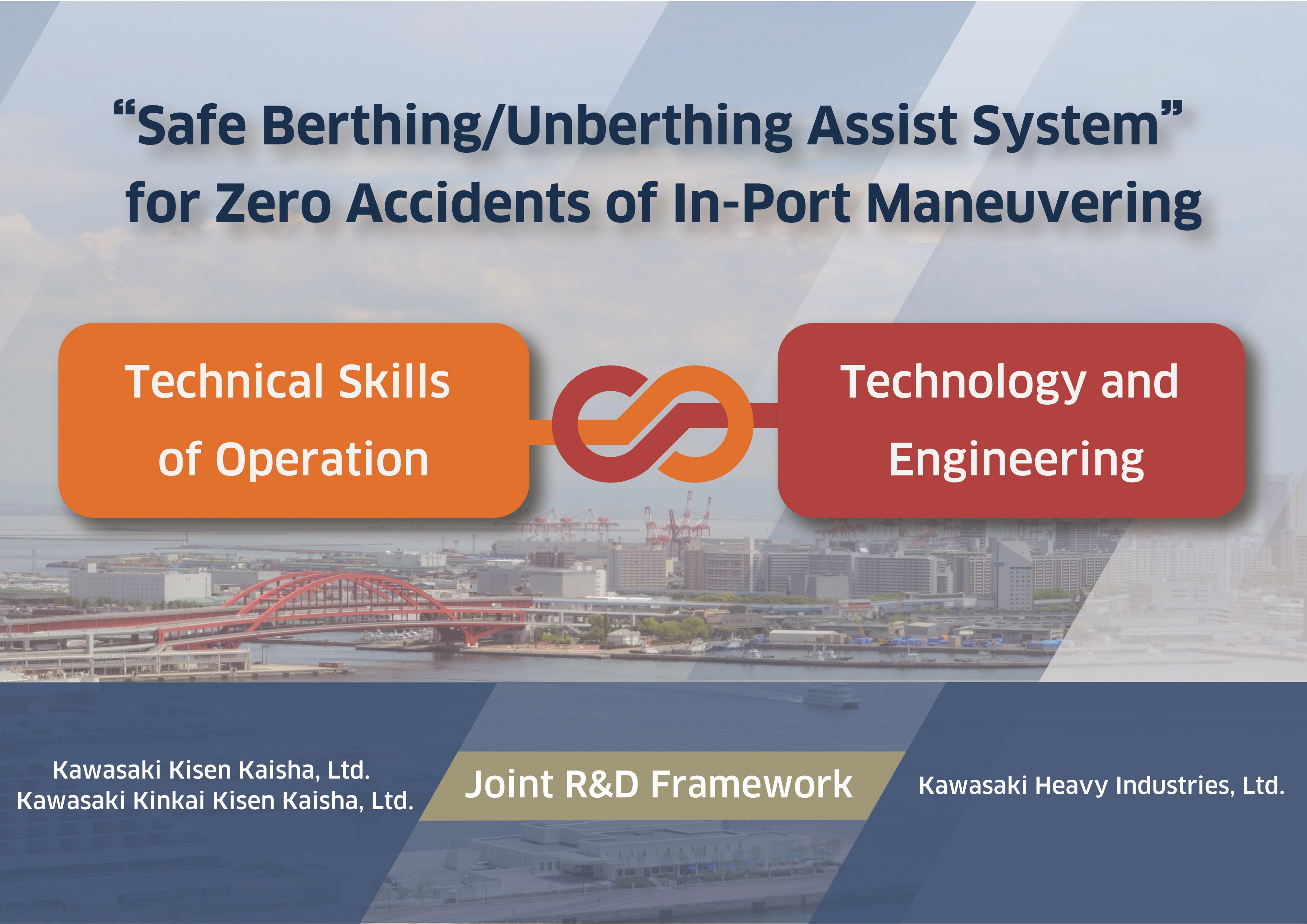Joint R&D Agreement Aimed at World’s First Practical Deployment of the “Safe Berthing/Unberthing Assist System” ~To improve safe ship operation and realize autonomous ships in the future~
Jan. 05, 2023
Tokyo, January 05, 2023 — Kawasaki Heavy Industries, Ltd. announced today its agreement to pursue a three-company joint research and development project together with Kawasaki Kisen Kaisha, Ltd. (“K” Line) and Kawasaki Kinkai Kisen Kaisha, Ltd. (“K” Line Kinkai), aimed at achieving practical deployments of the “Safe Berthing/Unberthing Assist System”. The system is designed to facilitate automatic maneuvering and mooring in order to enhance both safety and efficiency for in-port vessel maneuvering, berthing/unberthing, and mooring operations.
Through this research, the expertise of “K” Line and “K” Line Kinkai will be combined with Kawasaki’s system integration technologies for propulsion systems and mooring assistance technologies cultivated through its experience in the marine machinery business, all in the aim of solving problems encountered in berthing/unberthing and mooring operations, and ensuring enhanced safety performance therein.
Currently, berthing and unberthing operations are carried out by skilled crew with thoroughgoing knowledge and experience in vessel maneuvering technique, as well as the specific maneuverability characteristics and mooring equipment features of their own vessel. However, increasing ship sizes have made vessel maneuvering more sophisticated and challenging, while shortages of crew personnel have become a societal issue, both of which create demand for enhanced safety management in vessel maneuvering and mooring operations. The ”Safe Berthing/Unberthing Assist System” will utilize leading-edge technologies such as AI to assist in safe vessel maneuvering by pilots and reduce crew skill requirements, making it a promising potential solution to problems encountered in berthing and unberthing operations. The system will be the first of its kind to provide integrated, comprehensive support in the four areas of in-port vessel maneuvering, berthing and unberthing maneuvering, mooring operations, and mooring management. Its most prominent feature is coordinated control of propeller and mooring machinery to provide assistance in mooring operations. Research and development will be carried out under real-life conditions by using coastal vessels operated by “K” Line Kinkai, and through these efforts the three parties plan to complete the system by spring 2025.
System features
| (1) | Vessel maneuvering in-port: By utilizing advanced vessel motion prediction models and state-of-the-art situational awareness sensing technologies such as accurate position sensing and obstacle distance sensing, the system will support pilots through high-accuracy vessel motion prediction information such as future courses, speeds, and stop positions for ship’s commander. |
| (2) | Berthing/unberthing maneuvering: By feeding the vessel motion prediction information described in item 1 above into the KICS®*1 dynamic positioning system (DPS*2), which is developed and made by Kawasaki and used in numerous coastal vessels, it is possible to provide optimal automatic control of own-vessel speed and attitude, which are affected by constantly changing disturbance forces such as weather and sea conditions. |
| (3) | Mooring operations: Carrying out coordinated control of propeller and mooring-winch by using KICS® facilitates greater safety for both safe vessel maneuvering and safe crew operations during berthing and mooring operations. Furthermore, cameras and sensors enable monitoring and visualization of work being performed, which greatly reduces the risk of injury to crew members during mooring. |
| (4) | Mooring management: Project members will create a new system that can detect from on the ship tensile forces on mooring lines when the ship is moored, and monitor the tension and stress of mooring lines in real time and at any location inside the ship. Frequent checking and adjustments to said tension are required particularly in ports exposed to large tidal variances, and when ships undergo rapid draft changes. In such situations, the system can prevent problems related to mooring lines and reduce crew workload. |
Kawasaki manufactures propulsion equipment, DPS and mooring equipment, making it the only Japanese manufacturer capable of integrated, comprehensive engineering operations for everything from ship propulsion to mooring. KICS®, which is a DPS, is capable of providing integrated control of the propulsion propeller, side thrusters and other propulsion machinery. It also comes equipped with a route tracking function that automatically navigates on the planned route. To date, KICS® has built an impressive track record of automatic maneuvering technologies in Japan and abroad. Using KICS®-based control technologies as a foundation, Kawasaki and its partners will continue leveraging DPS technologies and advanced ICT in pursuit of R&D aimed at practical deployments of integrated control technologies for propeller and mooring machinery. In this way, the three companies are working to realize consistent safety enhancements from berthing to mooring management, as well as future autonomous ships, all in pursuit of marine mobility that is both safe and reliable.
| *1 | Kawasaki Integrated Control System (KICS) is a system capable of collectively controlling multiple types of propulsion machinery, including the controllable pitch propeller, azimuth thrusters, side thrusters, rudders, etc. (Reference: https://global.kawasaki.com/en/mobility/marine/machinery/kics.html) |
| *2 | A dynamic positioning system, or DPS, utilizes vessel position measurement equipment such as GPS to measure vessel positions in real time, and provides automated control of propulsion systems and rudders to prevent the ship’s straying from its intended position. |
Related reference materials explaining the “Safe Berthing/Unberthing Assist System”
Explanation of the “Safe Berthing/Unberthing Assist System”

Concept Diagram for the “Safe Berthing/Unberthing Assist System”

Contact
If you need more information about our business,
please feel free to contact us.





